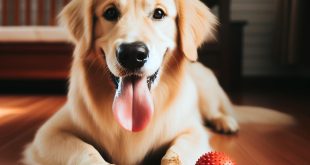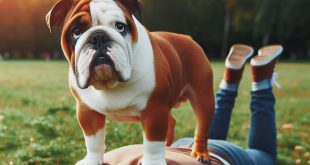Have you ever wondered why your furry companion finds great delight in rolling on any smelly, decomposing creature they come across during your walks? It may seem peculiar and somewhat repulsive to us humans, but for dogs, rolling on dead animals is a behavior deeply rooted in their ancestral instincts. Despite our efforts to domesticate them, our canine friends still carry traces of their wild nature, and this peculiar habit serves a crucial purpose in their social and communication repertoire. In this article, we will delve into the fascinating world of why dogs feel compelled to roll on dead animals, shedding light on the reasons behind this behavior in simple and accessible terms.
Table of Contents
Reasons Why Dogs Roll on Dead Animals
Dogs can exhibit some strange behaviors, and one of the most perplexing is their tendency to roll on dead animals. While this behavior may seem repulsive to us, it actually serves a purpose for our canine companions. In this section, we will explore the various reasons why dogs engage in this peculiar behavior.
1. Instinctual Behavior
Dogs have a strong instinct to disguise their own scent. This behavior can be traced back to their wild ancestors who needed to hide their smell to avoid being detected by potential predators or prey. By rolling on dead animals, dogs can mask their own scent and potentially gain an advantage in hunting or avoid being detected themselves.
2. Marking Territory
Rolling on dead animals can also be a way for dogs to mark their territory. By covering themselves with the scent of a dead animal, they are effectively claiming that area as their own. This behavior is especially common among male dogs, who are naturally more inclined to establish dominance and mark their territory.
3. Social Signaling
Another explanation for this behavior is social signaling. Dogs are highly social animals and use various forms of communication to interact with others. Rolling on a dead animal may serve as a way for a dog to communicate something to other dogs and even humans. It could be a way of expressing dominance, attracting a mate, or simply seeking attention from their human companions.
4. Curiosity and Investigation
Dogs are naturally curious creatures and often investigate their environment using their sense of smell. Rolling on a dead animal may simply be a way for a dog to explore and gather information about the scent. They rely heavily on their sense of smell to understand the world around them, and rolling on a dead animal could provide them with valuable olfactory insights.
5. Disguising Their Scent
As mentioned earlier, rolling on dead animals can help dogs mask their own natural scent. This can be particularly useful when hunting prey. By camouflaging their smell, dogs increase their chances of getting closer to their target without being detected. This behavior is deeply ingrained in their genetic makeup and remains prevalent even in domesticated dogs.
6. An Inherited Behavior
Some theories suggest that rolling on dead animals is an inherited behavior that has been passed down from their wild ancestors. Dogs share a common ancestry with wolves, and this behavior might have been more necessary in the wild to ensure survival.
7. Reinforcement from Humans
In some cases, dogs might roll on dead animals as a result of reinforcement from their human owners. If a dog receives attention or praise from rolling on a carcass, they may continue this behavior seeking positive reinforcement. This is why it is important not to inadvertently encourage or reward this behavior, especially if it is undesirable.
8. Comfort and Familiarity
Odd as it may seem, dogs may find comfort or familiarity in rolling on dead animals. The smell and texture might remind them of something in their past or provide a sense of security. It could also be a way for them to release stress or pent-up energy by engaging in a natural behavior that brings them comfort.
9. Attention-Seeking Behavior
Some dogs may roll on dead animals simply to gain attention from their owners or other dogs. Rolling on something so fascinating and unusual can often lead to people reacting or paying attention to the dog, which may be rewarding for them. Dogs are intelligent creatures and can quickly learn what behaviors get them the desired response.
10. Individual Preferences
Ultimately, each dog is an individual with their own unique personality and preferences. Some dogs may simply enjoy the smell and sensation of rolling on dead animals. It is important to recognize that not all dogs engage in this behavior, and those that do may have their own personal reasons for doing so.
In conclusion, dogs rolling on dead animals may seem strange and off-putting to us, but it is a behavior deeply rooted in their instincts and natural tendencies. From masking their scent to marking territory and seeking attention, dogs engage in this behavior for a variety of reasons. Understanding these motivations can help us better comprehend our canine companions and their fascinating behaviors.
1. The Instinctual Behavior of Dogs
Dogs, being descendants of wolves, possess a variety of instinctual behaviors that have been passed down through generations. Rolling on dead animals is one such behavior that can be observed in many dogs. In this section, we will delve deeper into the reasons behind this intriguing behavior.
2. The Scent Marking Theory
One possible explanation for why dogs roll on dead animals is the scent marking theory. Dogs have a highly developed sense of smell, and rolling on the carcass of a deceased animal allows them to absorb and carry the scent. By doing so, they communicate their presence to other dogs in the area. This behavior serves as a form of territorial marking, indicating to other canines that a particular area has been claimed.
3. Camouflaging the Natural Odor
Another theory suggests that dogs roll on dead animals to camouflage their own natural odor. By covering themselves with the scent of a deceased animal, they may be able to mask their own smell and make it harder for potential prey or predators to detect them. This behavior may have originated as a survival strategy in the wild when dogs had to hunt for food or protect themselves from larger predators.
4. A Remnant of Prey Drive
Dogs have retained many predatory instincts from their ancestors, and rolling on dead animals could be a remnant of their prey drive. In the wild, wolves and other wild canids would often roll on carcasses to mask their scent and gather information about potential prey in the area. This behavior can still be observed in domesticated dogs, even though they no longer need to hunt for survival.
5. Curiosity and Investigation
Rolling on dead animals may also be fueled by a dog’s inherent curiosity and need to investigate their surroundings. Dogs are highly inquisitive animals, and encountering a dead animal could trigger their instinct to explore and understand the scent, texture, and anatomy of the deceased creature. Rolling allows dogs to interact with the remains, satisfying their inquisitiveness and providing mental stimulation.
6. Social Behavior and Bonding
Rolling on dead animals is not limited to individual dogs; it can also be observed in social settings. Dogs might engage in this behavior when they are part of a pack or living in groups. Rolling together on a dead animal can facilitate bonding and create a shared scent among the group. This behavior reinforces social ties and improves communication within a pack or dog community.
7. A Source of Entertainment
Dogs often engage in activities that humans might find peculiar or disgusting, yet for them, it’s a source of entertainment. Rolling on a dead animal, despite its unsavory nature, might simply be an enjoyable and amusing pastime for some dogs. The tactile sensation, the novel smell, and the overall experience may bring them sheer delight, similar to how humans find different hobbies or activities pleasurable.
8. Individual Preferences and Variations
It is important to note that not all dogs exhibit this behavior, and those who do may have their own unique reasons for doing so. Some dogs might roll on dead animals more frequently or with greater intensity due to individual preferences or variations. The specific breed, temperament, early experiences, and training of a dog can all contribute to their inclination or aversion to this behavior.
9. Possible Health Benefits
Though rolling on dead animals might appear unhygienic to us, it could potentially offer some health benefits for dogs. Certain decomposing substances, such as organic acids and enzymes found in carcasses, could act as natural flea or parasite repellents. Rolling on these substances may help dogs alleviate pesky itches, mites, or ticks. However, dogs should preferably receive regular preventive treatments for parasites rather than relying solely on this behavior.
10. Owner Intervention and Training
If your dog’s propensity for rolling on dead animals becomes problematic or overly unpleasant, it is possible to intervene through training and redirection. Offering alternative activities, practicing recall commands, and rewarding desired behaviors can help deter dogs from engaging in this behavior. Dog owners should ensure that their pets have ample opportunities for physical exercise, mental stimulation, and social interaction to discourage them from seeking entertainment in rolling on deceased animals.
In conclusion, dogs rolling on dead animals stem from a combination of their inherent instincts, including territorial marking, prey drive, curiosity, and social behavior. While it may be an unpleasant habit for pet owners, understanding the reasons behind this behavior can help us prevent or redirect it more effectively. However, being mindful of potential health risks associated with decomposing animal matter and seeking appropriate preventive measures is crucial for the well-being of our canine companions.
The Instinctive Behavior of Rolling on Dead Animals
As baffling as it may seem to us, the innate behavior of dogs rolling on dead animals serves a specific purpose. This behavior has its roots deeply embedded in their evolutionary history and is driven by a combination of instinctual urges and sensory stimuli. In this section, we will explore the various reasons behind this seemingly unappealing behavior.
1. Scent Marking and Communication
Dogs are highly territorial animals and use scent marking as a means of communication. Rolling on dead animals allows them to acquire and transfer new scents onto their fur, thereby enhancing their olfactory signature. By transferring the scent of a dead animal onto their body, dogs can convey valuable information to other canines in their pack or territory. This scent marking serves as a form of communication, indicating their presence, dominance, and territorial claim to other dogs in the area.
2. Camouflage and Masking
Another reason dogs roll on dead animals can be attributed to their instinctual need for survival in the wild. By rolling on the carcass of a dead animal, dogs can effectively mask their own scent with the strong odor of the decomposing animal. This behavior serves as a natural camouflage technique, making it harder for potential prey to detect their presence and increasing their chances of a successful hunt. Dogs retain this survival instinct even in domestic settings, where their ancestral behaviors can still come to the forefront.
3. Ancestral Hunting Behavior
The act of rolling on dead animals can harken back to the hunting techniques employed by their ancestral predecessors, such as wolves. Wolves often roll on the carcasses of their prey to saturate their fur with the scent, thus allowing them to return to their pack with evidence of a successful hunt. This behavior also helps them in disguising their true intentions from potential competitors or scavengers who might try to steal their hard-earned meal. Despite the stark contrasts between modern dogs and their wild ancestors, these primal instincts remain ingrained within their genetic makeup.
4. Refreshing Exploitation of Odors
Dogs possess an exceptional sense of smell, significantly superior to that of humans. Rolling on dead animals, which emit a pungent combination of decay and other scents, can be seen as a way for dogs to engage in sensory stimulation and refresh their exploitation of odors. Since their sense of smell plays a fundamental role in their world, rolling on dead animals may simply be a means for dogs to satisfy their olfactory curiosity and explore the rich tapestry of smells around them.
5. Pure Enjoyment and Stimulation
Contrary to the potential survival and communication aspects mentioned earlier, rolling on dead animals might also be driven by pure enjoyment and sensory stimulation. While it may be difficult for us to comprehend the pleasure derived from such activities, dogs have different sensory experiences than humans. The strong smells, textures, and other sensory inputs associated with rolling on carcasses may provide dogs with a unique form of amusement and gratification, similar to how they relish in rolling on grassy fields or dusty surfaces.
| Reasons | Summary |
|---|---|
| Scent Marking and Communication | By rolling on dead animals, dogs transfer unique scents to communicate with other canines in their pack or territory. |
| Camouflage and Masking | Dogs use the strong odor of the decomposing animal to mask their own scent, enhancing their chances of successful hunting. |
| Ancestral Hunting Behavior | This behavior reflects the hunting techniques of their wild ancestors, helping them protect their prey and deceive competitors. |
| Refreshing Exploitation of Odors | Dogs indulge in rolling on dead animals to satisfy their olfactory curiosity and engage in sensory stimulation. |
| Pure Enjoyment and Stimulation | Rolling on carcasses provides dogs with a unique form of amusement and gratification due to their distinctive sensory experiences. |
Thanks for Joining Us on This Canine Adventure!
We hope this article shed some light on the mysterious and intriguing behavior of dogs rolling on dead animals. Our furry friends are truly fascinating creatures with their own unique quirks and instincts. So the next time you see your furry companion indulging in this peculiar habit, remember that it’s just their way of connecting with their primal instincts and claiming a scent-tastic victory! We’d like to extend our heartfelt thanks for joining us on this journey. Be sure to check back soon for more delightful and informative pet-related articles. Until then, wagging tails and wet noses from all of us here!
 Treat For Dog – Brain Training for Dogs, Dog Training & Obedience Discover Treat For Dog and get your pup on the path to smarter, happier, and healthier living with brain training for dogs.
Treat For Dog – Brain Training for Dogs, Dog Training & Obedience Discover Treat For Dog and get your pup on the path to smarter, happier, and healthier living with brain training for dogs.




